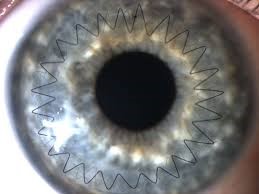Cornea
Dr. Lee trained at the most highly sought-after cornea fellowship in the country and is an experienced cornea surgeon. The past decade has been a period of exciting progress in the field of cornea transplantation, and Dr. Lee offers all types of cornea transplants, both partial and full.
The cornea is the window in the front of the eye, and the healthy cornea is clear and about half a millimeter thick. The cornea provides about two-thirds of the focusing power of the eye, so a healthy cornea is critical to your vision. Dr. Lee has performed hundreds of transplants and will perform a thorough assessment to recommend the type that is best for you.
DMEK (Descemet Membrane Endothelial Keratoplasty)
Dr. Lee was one of the first surgeons in the Bay Area to perform DMEK. This advanced partial thickness transplant removes the diseased back layer of the cornea (seen in green in the following cornea diagram) and replaces it with an identical layer.
Because the transplant is an exact anatomic replacement, DMEK patients on average have better vision, faster recovery, and lower risk of rejection than other transplant recipients. To allow the transplant to adhere without the use of sutures, a special air bubble is placed in the eye that takes several days to dissolve.
DSAEK (Descemet Stripping Automated Endothelial Keratoplasty)
Another partial thickness transplant, DSAEK uses a slightly thicker replacement layer than DMEK. This can be preferable in eyes that have certain types of anatomy or if you have had prior glaucoma surgery. Both of these partial thickness transplants provide a much more rapid recovery than traditional full thickness transplant, with significantly less risk of rejection and greater structural resistance to trauma.
DALK (Deep Anterior Lamellar Keratoplasty)
Sometimes keratoconus or scarring requires replacement of the front layers of the cornea, seen as the pink and blue layers in the diagram. DALK allows replacement of only these layers while preserving the deepest layers of the cornea. By doing so, the eye retains greater structural support than a full thickness transplant in the case of trauma. Furthermore, the inner layers are the ones most likely to experience rejection from the body’s immune system. DALK cannot be performed successfully in every eye because of anatomic considerations.
After the DALK transplant is sewn into place, the sutures need to be removed gradually after surgery, usually over an 18-month period.
Full Thickness Transplant (Penetrating Keratoplasty)
The cornea was the first solid organ to be transplanted successfully in 1905. Full-thickness cornea replacement remains an excellent surgery for many cornea conditions, including patients with keratoconus, scarring, or other conditions that involve all five layers of the cornea. At your visit, Dr. Lee will discuss the relative advantages to a partial or full transplant approach for your situation. Similarly to DALK, the sutures holding the transplant will be removed gradually.

Complex surgery
Thanks to his advanced training in cornea, cataract, and glaucoma surgery, Dr. Lee has extensive experience in dealing with complex surgical problems involving the front part of the eye. As a result, he is the one of the only surgeons in Northern California offering the artificial iris implant. When he was at the University of Washington, other eye surgeons throughout the Pacific Northwest, Alaska, and Hawaii sent him their most complex cases. He now brings this background to the Bay Area.
Sutured Intraocular Lenses
Whenever possible, it is preferable to use the lens capsule, the natural envelope inside the eye, to hold the artificial lens in position. However, if there is damage to the support structures inside the eye, it is sometimes necessary to suture the artificial lens instead. Depending on the anatomy of your eye, Dr. Lee may suture the lens either to the iris, the colored part of the eye, or the sclera, the white part of the eye.
Iris Repair
Some people have a congenital condition that results in defects in the iris. Other times, these defects occur because of surgery or trauma. Occasionally, the problem is not a hole in the iris but instead is scarring that pulls the iris forward and causes problems with eye pressure or threatens the health of the cornea. Dr. Lee has done many procedures to treat iris problems from all of these etiologies.
Intraocular Lens Exchange
Fortunately, the vast majority of intraocular lenses are stable and work very well. However, when there is a problem with a lens, you want a surgeon, such as Dr. Lee, who has dealt with this complex surgery on many occasions.
